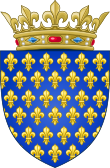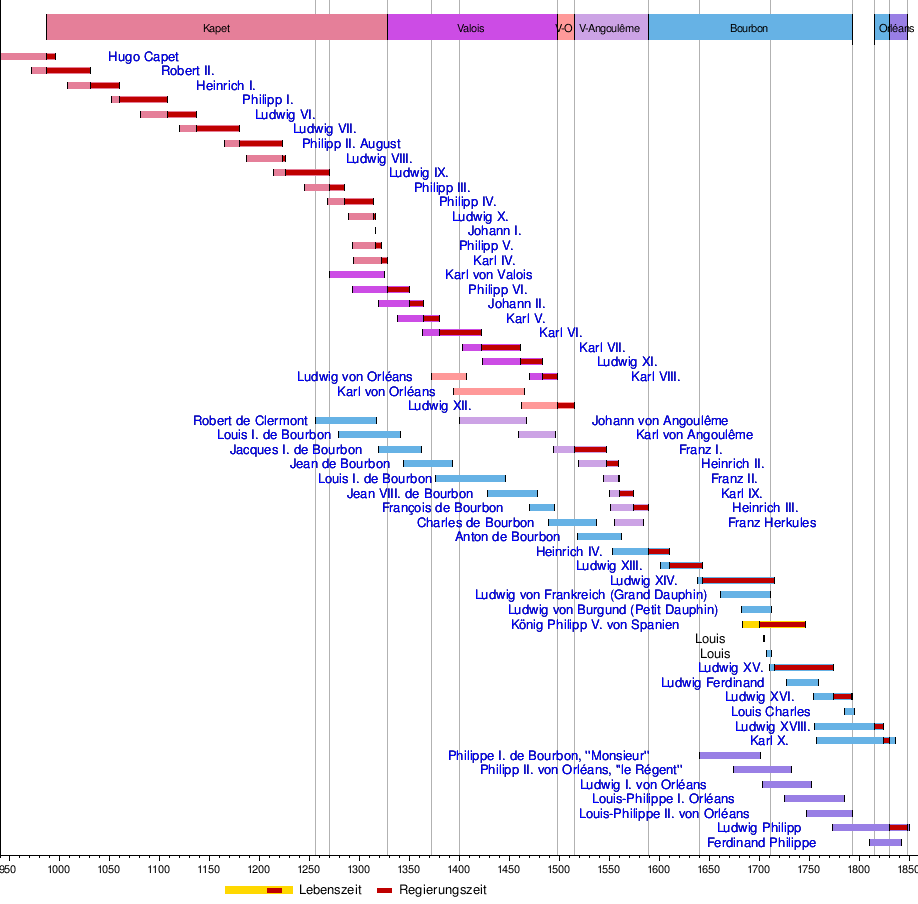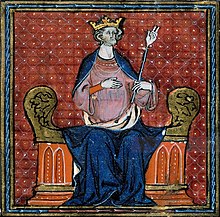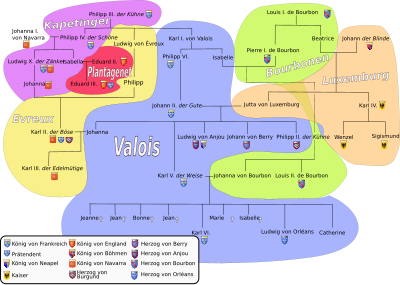Capetians

The Capetians (French Capétiens ), also simply called House Capet in a modern paraphrase , are an aristocratic family of Franconian origin , which is considered by the historiography of France as the third French ruling family after the Merovingians and the Carolingians . As kings of the Franks ( reges Francorum) and from the 13th century as kings of France (reges Franciae) , the Capetians played a prominent role in the development of the French nation that emerged from the West Franconian part (Francia occidentalis) and in the establishment of the central French state .
The progenitor and namesake of the family is King Hugo Capet , who was a member of the Frankish aristocratic Robertin family, which was attested from the 7th century . In the broader sense, all agnatic descendants of Hugo Capet are members of this sex, in a narrower sense only the kings ruling France between 987 and 1328 are called Capetians, but all subsequent kings were members of subsidiary lines of the Capet dynasty.
As a direct continuation of the Robertines, the Capetians represent the oldest ruling family of the European high nobility still existing in the direct male line, represented by the houses Bourbon , Orléans and Braganza . In the course of its over a thousand-year history, it represented the kings of France as well as a large number of monarchs from already extinct and still existing monarchies. The current ruling monarchs of Capetian descent are King Philip VI. of Spain and Grand Duke Henri of Luxembourg .
Surname
The meaning of the word capet is unclear today; possible is an origin from the Latin “caput” , which means head or head and thus could stand for “leader” or “chief” in the figurative sense. What is certain is that it is not a surname in the classic sense, but an honorable nickname.
The epithet "Capet", which is characteristic of King Hugo today, was neither contemporary nor was it first used for his person. A few years after his death, his father, the dux francorum Hugo Magnus , was first mentioned in the history of Ademar von Chabannes († 1034) as Ugoni Capetio ducatum . But shortly afterwards the epithet was first referred to King Hugo in the middle of the 11th century in a retrospective entry for the year 1031 in the chronicle of the Abbey of Saint-Médard von Soissons (Robertus [Robert II.] Inclytus Rex Francorum, filius Hugonis Chapez [ Hugo Capet], ...) . In the 12th century, Robert von Torigni († 1186) affirmed in his revision of the Gesta Normannorum Ducum the name separation between the dux Hugo Magnus and the King Hugo Capet (Supradictus vero Hugo Magnus [Hugo Magnus] genuit ex filia Ottonis regis Saxonum [Hadwig von Saxony], postmodum uero imperatoris Romanorum, Hugonem Capeiet [Hugo Capet] et fratres eius.) .
Around the same time as Robert von Torigni, the Anglo-Norman author Radulfus de Diceto († 1202) first applied the term capétien to the entire royal family of France in his second work, Ymagines Historiarum . He was also the first to provide an explanation for this name, according to which it is derived from the mantle of St. Martin of Tours , which was simply called cappa . Saint Martin was the patron saint of the first Capetian kings before he was ousted by Saint Dionysius in the 12th century . Both Hugo Magnus and Hugo Capet acted as lay abbots of the Abbey of Saint-Martin of Tours , where the gray-blue cloak relic was kept and was finally carried as a banner by the first Capetians.
The name Capet established itself in colloquial usage no later than the 13th century in France as a dynasty name for the royal family, which, however, referred to itself as Maison de France (House of France) . In the first work on the official French historiography that began in the 13th century, the Roman aux rois des primacy of Saint-Denis , a dynastic periodization of the history of the Franks into the three royal families (Merovingians, Carolingians, Capetians) was made for the first time.
Establishment of a dynasty
In 987 the Robertine Hugo Capet was elected their new king by the West Franconian clergy and aristocracy after the Carolingian Ludwig V had died. At the time, this was not the first breach of blood law in the succession to the West Franconian royal throne; before Hugo, his great-uncle Odo and his grandfather Robert I were already elected kings as counter-pretenders to the Carolingian dynasty. However, since the Carolingians were able to take over the throne again after their death, it was not foreseeable that Hugo's contemporaries would establish a new royal dynasty, especially since a Carolingian pretender still existed in the form of Duke Karl of Lower Lorraine . In order to secure the kingship for his family, Hugo had his son Robert II crowned co-king in the year of his coronation , so that when his father died in 996 he was able to succeed as sole ruler immediately and without another coronation or election.
Capétiens directs
"Capétiens directs" (direct Capetians) are the kings of France from 987 to 1328, as they represent an uninterrupted line of succession in the kingship from father to son.
Despite the end of the Carolingian family with the death of Duke Otto of Lower Lorraine in 1005/06, Hugo Capet's descendants stuck to the succession plan he had practiced for several generations. This mainly depended on the particular political weakness of the first Capetian kings in the 11th and 12th centuries, whose real rulership was limited to a core region in their kingdom, today comparable to the Île-de-France , due to the feudalism established in West Franconia . Furthermore, their general reputation was damaged by the assumption that they had come to the throne only through a breach of blood rights.
This changed, however, from the reign of King Philip II Augustus (1180-1223), from which the kingship began to overcome feudalism and replace it with the idea of a centralized state idea, the monarchy , tailored to the king . The work of Philip II was continued and consolidated by his immediate successors, in which especially Louis IX. the saint (1226–1270) and Philip IV the Handsome (1285–1314) stand out. The establishment of the royal central state also promoted the early development of a French national consciousness, Philip II Augustus was the first to be called "King of France", his victory in the Battle of Bouvines in 1214 was considered by contemporary authors to be a victory for the French people stylized about the English and the Teutons. The Capetians also experienced their ideological breakthrough in their acceptance as the legitimate French royal house in the 13th century, when they claimed dynastic continuity with the Carolingians, which they based on a legendary prophecy by St. Walaric . Hugo Capet is said to have predicted that his house would rule for seven generations, after which the tribe of Charlemagne would return to the throne of the Franks (Reditus regni Francorum ad stirpem Karoli Magni) . Philip II Augustus was the seventh Capetian king and he had already claimed an ascendency to the Carolingians through his mother Adela of Champagne . But it was only in the genealogy of Louis VIII the Lion (1223–1226) that the prophecy was successfully proven by the Abbot of the Benedictines of Marchiennes . He saw this prediction confirmed in the fact that Louis VIII was the son of Isabella von Hainaut , whose family allegedly descended in direct line from the great emperor.
Through the dynastic connection to the Carolingians, which ironically relied on a female line of succession, they were not only to be given the justification of their legitimacy, but also to be granted a right to universal royal power, as they would have once had the Carolingians.
Valois, Bourbon and Orléans
With the death of King Charles IV (1322-1328), the direct line of the Capetians ended, as neither he nor his brothers had left sons entitled to inherit according to Salian law . However, by this time the dynasty had already ramified into several subsidiary lines that could put pretenders on the throne. In 1328, with the support of the Estates General, the Count of Valois proclaimed himself Philip VI. (1328–1350) as the new king. On his father's side he was a grandson of King Philip III. the Bold (1270–1285) and established the rule of the House of Valois . Against the claims of the English kings to the French throne, which they claimed through female succession, the Valois had to fight the Hundred Years War , which they were able to end victoriously in the 15th century.
The House of Valois followed in 1589 with King Henry IV (1589–1610), the House of Bourbon , which was run by Louis IX. descended from the saint. During the French Revolution , which broke out in 1789 , the monarchy was abolished for the first time in 1792 and restored after the end of Napoleon Bonaparte's rule in 1814/1815 .
After the July Revolution of 1830 , the monarchy assumed a constitutional character and was occupied by a representative of the House of Orléans , which in turn descended from the Bourbons. King Louis-Philippe I , however, was deposed by the February Revolution in 1848 and was thus the last French monarch of the Capetians.
Overview of the main lines



- The Robertines were the ancestors of the Capetians, branching off from them
- the Franconian Babenberger or Popponen as well as the
- direct line of the Capetians (Kings of France 987–1328). Their sidelines are:
- the House of Valois (kings of France 1328–1589), with its subsidiary lines:
- the House of Valois-Alençon ( Counts and Dukes of Alençon 1326–1526)
- the House of Valois-Burgundy ( Dukes of Burgundy 1363–1482)
- the house of Valois-Anjou ( Dukes of Anjou 1360–1480, titular kings of Naples-Sicily)
- the house of Valois-Orléans (King of France 1498–1515)
- the house of Valois-Angoulême (kings of France 1515–1589)
- the House of Bourbon (Kings of France 1589–1792, 1814–1830), probably the most important, still existing branch of the Capetians, which itself has numerous branch lines, especially:
- the House of Bourbon-Anjou (Kings of Spain 1700–1808, 1813–1868, 1874–1931 and since 1975), from which
- the House of Bourbon-Sicily ( Kings of Naples-Sicily 1735–1861) and
- the House of Bourbon-Parma (Dukes of Parma 1748–1801 and 1847–1860, Kings of Etruria 1801–1807, Grand Dukes of Luxembourg since 1964) branch off
- the house of Orléans ( July Monarchy 1830–1848)
- the house of Bourbon-Condé
- the House of Bourbon-Anjou (Kings of Spain 1700–1808, 1813–1868, 1874–1931 and since 1975), from which
- the House of Valois (kings of France 1328–1589), with its subsidiary lines:
- Further branches of the direct Capetians are:
- the House of Burgundy ( Dukes of Burgundy 1027-1361), from which
- the House of Burgundy-Portugal (Alfonsine) (Kings of Portugal 1089-1383), of these
- the house of Avis (kings of Portugal 1383–1580) and from this in turn
- the House of Braganza (Kings of Portugal 1640–1853, Emperor of Brazil 1822–1889) branch off.
- the house of Avis (kings of Portugal 1383–1580) and from this in turn
- the House of Burgundy-Portugal (Alfonsine) (Kings of Portugal 1089-1383), of these
- the House of Vermandois (Counts of Vermandois 1080–1167)
- the House of Courtenay ( Latin Emperor of Constantinople 1217–1261)
- the house of Dreux ( dukes of Brittany 1221–1514)
- the House of Artois ( Counts of Artois and Eu 1226–1472)
- the house of Anjou (kings of Naples-Sicily 1266–1282 / 1435, of Hungary 1301–1414, of Poland 1370–1399 and titular kings of Jerusalem )
- the house of Évreux ( kings of Navarre 1328–1441).
- the House of Burgundy ( Dukes of Burgundy 1027-1361), from which
Tribe list of Capetians (direct line)
A detailed description can be found in the main article “ Tribe List of Capetians” .
|
Hugo Capet (987-996) |
|||||||||||||||||||||||||||||
|
Robert II the Pious (996-1031) |
|||||||||||||||||||||||||||||
|
Henry I (1031-1060) |
House of Burgundy (until today) |
||||||||||||||||||||||||||||
|
Philip I (1060-1108) |
House Vermandois (until 1213) |
||||||||||||||||||||||||||||
|
Louis VI. the thick (1108–1137) |
|||||||||||||||||||||||||||||
|
Louis VII the Younger (1137–1180) |
Dreux House (until 1514) |
House Courtenay (until 1768) |
|||||||||||||||||||||||||||
|
Philip II August (1180-1223) |
|||||||||||||||||||||||||||||
|
Louis VIII the Lion (1223-1226) |
|||||||||||||||||||||||||||||
|
Louis IX the saint (1226-1270) |
House Artois (until 1472) |
House Anjou (until 1435) |
|||||||||||||||||||||||||||
|
Philip III the bold (1270–1285) |
House Bourbon (until today) |
||||||||||||||||||||||||||||
|
Philip IV the Handsome (1285-1314) |
House Valois (until 1589) |
House Évreux (until 1441) |
|||||||||||||||||||||||||||
|
Louis X. the brawler (1314-1316) |
Philip V the Tall (1316-1322) |
Charles IV the Handsome (1322-1328) |
|||||||||||||||||||||||||||
|
John I the Posthumous (1316) |
|||||||||||||||||||||||||||||
Rulers lists
-
Kings of West Franconia, Kings of France, Kings of the French
- Odo (888-898)
- Robert I. (922-923)
- Hugo Capet (987-996)
- Robert II (996-1031)
- Henry I (1031-1060)
- Philip I (1060-1108)
- Louis VI. (1108–1137)
- Louis VII (1137–1180)
- Philip II (1180-1223)
- Louis VIII (1223-1226)
- Louis IX (1226-1270)
- Philip III (1270-1285)
- Philip IV (1285-1314; Philip I of Navarre)
- Louis X. (1314-1316; Louis I of Navarre)
- John I (1316; John I of Navarra)
- Philip V (1316-1322; Philip II of Navarre)
- Charles IV (1322-1328; Charles I of Navarre)
- Philip VI (1328-1350)
- John II (1350-1364)
- Charles V (1364-1380)
- Charles VI (1380-1422)
- Charles VII (1422–1461)
- Louis XI. (1461–1483)
- Charles VIII (1483–1498)
- Louis XII. (1498–1515)
- Francis I (1515-1547)
- Henry II (1547–1559)
- Francis II (1559-1560)
- Charles IX (1560–1574)
- Henry III. (1574–1589; Henry of Poland)
- Henry IV (1589–1610; Henry III of Navarre)
- Louis XIII (1610–1643; Ludwig II of Navarre)
- Louis XIV (1643–1715; Louis III of Navarre)
- Louis XV (1715–1774; Louis IV of Navarre)
- Louis XVI (1774–1792; Louis V of Navarre)
- Louis XVIII (1814 / 1815–1824; Louis VII of Navarre)
- Charles X (1824–1830; Charles IV of Navarre)
- Ludwig Philipp (1830–1848)
-
latin emperor of constantinople
- Peter (1216-1217)
- Robert (1217-1228)
- Baldwin II (1228-1261)
-
Kings and Queens of Sicily-Naples
- Charles I (1266-1285)
- Charles II (1285–1309)
- Robert (1309-1343)
- Johanna I. (1343-1382)
- Charles III (1382–1386; Charles II of Hungary)
- Ladislaus (1386-1414)
- Joan II (1414-1435)
- René (1435-1442)
- Louis (1501–1504; Louis XII of France)
- Philip IV (1700–1713; Philip IV of Sicily, Philip V of Spain)
- Charles VII (1735–1759; Charles V of Sicily, Charles I of Parma, Charles III of Spain)
- Ferdinand IV. (1759–1806 and 1815–1816; Ferdinand III. Of Sicily, Ferdinand I of both Sicilies)
-
Kings and Queens of Sicily
- Charles I (1266–1282)
- Philip IV (1700–1713; Philip IV of Naples, Philip V of Spain)
- Charles V (1735–1759; Charles VII of Naples, Charles I of Parma, Charles III of Spain)
- Ferdinand III. (1759–1816; Ferdinand IV. Of Naples, Ferdinand I of both Sicilies)
-
Kings of both Sicilies
- Ferdinand I (1816-1825)
- Francis I (1825-1830)
- Ferdinand II (1830-1859)
- Francis II (1859-1860)
-
Kings and Queens of Hungary
- Charles I (1301-1342)
- Ludwig I (1342–1382; Ludwig I of Poland)
- Mary (1382)
- Charles II (1382-1386; Charles III of Naples)
- Maria (1386-1395)
- Kings and Queens of Poland
-
Dukes of Parma
- Charles VII (1731–1735; Charles V of Sicily, Charles VII of Naples, Charles III of Spain)
- Philip (1748–1765)
- Ferdinand (1765-1802)
- Karl Ludwig (1847–1849; Karl Ludwig of Etruria)
- Charles III (1849-1854)
- Robert (1854-1860)
-
Kings of Etruria
- Ludwig I (1801-1803)
- Karl Ludwig (1803–1807; Karl Ludwig of Parma)
- Grand Dukes of Luxembourg
-
Kings and Queens of Navarre
- Philip I (1285–1305; Philip IV of France)
- Louis I (1305–1316; Louis X. of France)
- John I (1316; John I of France)
- Philip II (1316-1322; Philip V of France)
- Charles I (1322-1328; Charles IV of France)
- Joan II (1328-1349)
- Philip III (1328–1342)
- Charles II (1349-1387)
- Charles III (1387-1425)
- Blanka (1425-1441)
- Anton (1555–1562)
- Henry III. (1572–1610; Henry IV of France)
- Louis II. (1610–1643; Louis XIII. Of France)
- Ludwig III. (1643–1715; Louis XIV of France)
- Louis IV (1715–1774; Louis XV of France)
- Louis V (1774–1791; Louis XVI of France)
- Louis VII (1814 / 1815–1824; Louis XVIII of France)
- Charles IV (1824–1830; Charles X of France)
-
Kings and Queens of Spain
- Philip V (1700–1724 and 1724–1746; Philip IV of Naples, Philip IV of Sicily)
- Ludwig I (1724)
- Charles III (1746–1759; Charles VII of Naples, Charles I of Parma, Charles V of Sicily)
- Charles IV (1759-1808)
- Ferdinand VII. (1808 and 1813-1833)
- Isabella II (1833-1868)
- Alfonso XII (1874-1885)
- Alfonso XIII (1886–1941)
- Johann Karl (1975-2014)
- Philip VI (since 2014)
-
Kings and Queens of Portugal
- Alfonso I (1139–1185)
- Sancho I (1185-1211)
- Alfonso II (1211-1223)
- Sancho II (1223-1248)
- Alfons III (1248-1279)
- Dionysius (1279-1325)
- Alfonso IV (1325-1357)
- Peter I (1357-1367)
- Ferdinand I (1367-1383)
- Johann I (1385-1433)
- Eduard (1433-1438)
- Alfonso V (1438–1481)
- John II (1481–1495)
- Manuel I (1495-1521)
- Johann III. (1521–1557)
- Sebastian (1557–1578)
- Heinrich I (1578–1580)
- Antonio (1580)
- John IV (1640-1656)
- Alfonso VI (1656–1682)
- Peter II (1682-1706)
- Johann V (1706–1750)
- Joseph I. (1750–1777)
- Peter III (1777–1786)
- Maria I (1786–1816; Maria I of Brazil)
- Johann VI. (1816–1826; John I of Brazil)
- Peter IV (1826; Peter I of Brazil)
- Maria II. (1826-1828 and 1834-1853)
- Michael I (1828-1834)
- Kings and Queens of Brazil, Emperors of Brazil
Timetable
Kings of France

Current pretenders of Capetian descent
- Luis Alfonso de Borbón y Martínez-Bordiú (* 1974; House Bourbon-Anjou), legitimist pretender for France, senior capet
- Jean Charles Pierre Marie d'Orléans (* 1965; House Orléans), Orléan pretender for France
- Duarte III. Pio de Bragança (* 1945; House Braganza), pretender for Portugal
- Luís Gastão de Orléans e Bragança (* 1938; House Orléans-Braganza), pretender for Brazil in competition with Pedro Carlos
- Pedro Carlos de Orléans e Bragança (* 1945; House Orléans-Braganza) pretender for Brazil in competition with Luís Gastão
- Carlos de Borbón-Dos Sicilias y Borbón-Parma (1938–2015, House Bourbon-Sicily), pretender for Both Sicilies in competition with Carlo
- Carlo di Borbone-Due Sicilie (* 1963; House Bourbon-Sicily), pretender for Both Sicilies in competition with Carlos
- Carlos Xavier Bernardo Sixtus Maria of Bourbon-Parma (* 1970, House Bourbon-Parma), pretender for Parma
- Sixtus Henri de Borbón-Parma y Borbón-Busset (* 1940 Bourbon-Parma house), Carlist pretender for Spain
Senior Capets
- Charibert († before 636)
- Chrodobertus (attests 630)
- Lantbertus I. († after 650)
- Chrodobertus (after 650 – after 678)
- Lantbertus II. (After 678 – before 741)
- Rutpert I. (before 741 – before 764)
- Thurincbertus (before 764-770)
- Rutpert II. (770-807)
- Rutpert III. (807 - before 843)
- Robert the Brave (before 843–866)
- Odo of West Franconia (866–898)
- Robert I of West Franconia (898–923)
- Hugo Magnus (923-956)
- Hugo Capet of France (956-996)
- Robert II of France (996-1031)
- Henry I of France (1031-1060)
- Philip I of France (1060–1108)
- Louis VI. of France (1108–1137)
- Louis VII of France (1137–1180)
- Philip II of France (1180-1223)
- Louis VIII of France (1223-1226)
- Louis IX of France (1226–1270)
- Philip III of France (1270–1285)
- Philip IV of France (1285-1314)
- Louis X of France (1314-1316)
- John I of France (1316)
- Philip V of France (1316-1322)
- Charles IV of France (1322-1328)
- Philip VI of France (1328-1350)
- John II of France (1350-1364)
- Charles V of France (1364-1380)
- Charles VI of France (1380-1422)
- Charles VII of France (1422–1461)
- Louis XI. of France (1461–1483)
- Charles VIII of France (1483–1498)
- Louis XII. of France (1498-1515)
- Francis I of France (1515–1547)
- Henry II of France (1547–1559)
- Francis II of France (1559-1560)
- Charles IX of France (1560–1574)
- Henry III. of France (1574–1589)
- Henry IV of France (1589–1610)
- Louis XIII of France (1610–1643)
- Louis XIV of France (1643–1715)
- Louis XV of France (1715–1774)
- Louis XVI of France (1774–1793)
- Louis Charles de Bourbon, duc de Normandie (1793–1795)
- Louis XVIII of France (1795–1824)
- Charles X of France (1824-1836)
- Louis-Antoine de Bourbon, duc d'Angoulême (1836–1844)
- Henri de Bourbon-Artois, comte de Chambord (1844-1883)
- Juan Carlos de Borbón y Bragança, conde de Montizón (1883–1887)
- Carlos María de los Dolores de Borbón y Austria-Este, duque de Madrid (1887–1909)
- Jaime de Borbón y Borbón-Parma, duque de Madrid (1909–1931)
- Alfonso Carlos de Borbón y Austria-Este, duque de San Jaime y de Anjou (1931-1936)
- Alfonso XIII of Spain (1936–1941)
- Jaime de Borbón y Battenberg, duque de Segovia (1941–1975)
- Alfonso Jaime de Borbón y Dampierre, duque de Cádiz (1975–1989)
- Luis Alfonso de Borbón y Martínez-Bordiú, duque de Anjou (since 1989)
Saints
- King Louis IX of France († 1270), St. August 11, 1297, feast day on August 25
- Bishop Ludwig of Toulouse († 1297), St. April 13, 1317, feast day on August 19
- Queen Hedwig of Poland († 1399), St. June 8, 1997, feast day July 17
literature
- Ingmar Krause: Conflict and ritual in the domain of the early Capetians - investigations into the representation and function of symbolic behavior. Rhema-Verlag, Münster 2006, ISBN 978-3-930454-62-4
- Joachim Ehlers : Die Kapetinger (= Urban pocket books 471). Kohlhammer, Stuttgart et al. 2000, ISBN 3-17-014233-X .
- Joachim Ehlers, Heribert Müller , Bernd Schneidmüller (eds.): The French kings of the Middle Ages. From Odo to Charles VIII. 888–1498. Beck, Munich 1996, ISBN 3-406-40446-4 .
Remarks
- ↑ For the use and meaning of the epithet, see Ferdinand Lot : Etudes sur le règne de Hugues Capet et la fin du Xe siècle , Appendix VI, pp. 304–323 (Paris, 1903)
- ↑ Raoul de Diceto, Ymagines Historiarum , ed. by William Stubbs: The Historical Works of Ralpf of Diss , in: Rolls Series 68 (1876), Vol. 1, pp. 290-291 and 440
- ^ Gesta Francorum usque ad annum (1214)
- ↑ Andreas von Marchiennes: L'Historia succincta de gestis et successione regnum francorum (1196)


